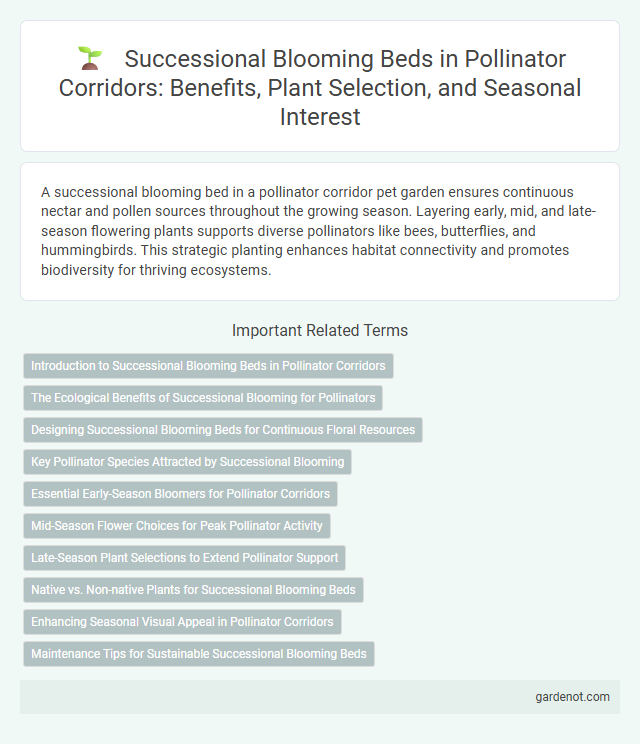A successional blooming bed in a pollinator corridor pet garden ensures continuous nectar and pollen sources throughout the growing season. Layering early, mid, and late-season flowering plants supports diverse pollinators like bees, butterflies, and hummingbirds. This strategic planting enhances habitat connectivity and promotes biodiversity for thriving ecosystems.
Introduction to Successional Blooming Beds in Pollinator Corridors
Successional blooming beds in pollinator corridors provide continuous floral resources by featuring a sequence of plant species that bloom at staggered intervals throughout the growing season. This strategic planting supports diverse pollinator populations, including bees, butterflies, and hummingbirds, by ensuring a steady supply of nectar and pollen. Implementing these beds enhances ecosystem resilience and promotes biodiversity, making them a vital component of sustainable habitat restoration efforts.
The Ecological Benefits of Successional Blooming for Pollinators
Successional blooming beds provide continuous floral resources throughout the growing season, supporting a diverse array of pollinators such as bees, butterflies, and hummingbirds. This extended availability of nectar and pollen enhances pollinator nutrition, improves reproduction rates, and stabilizes local ecosystems by promoting biodiversity. Incorporating native plants with staggered bloom times in pollinator corridors boosts ecological resilience and sustains healthy pollinator populations critical for ecosystem services.
Designing Successional Blooming Beds for Continuous Floral Resources
Designing successional blooming beds involves selecting a diverse array of native flowering plants that bloom at staggered intervals throughout the growing season to provide continuous nectar and pollen for pollinators. Incorporating early spring bloomers like Salix species, mid-summer native asters, and late-season goldenrods ensures sustained floral resources for bees, butterflies, and other pollinators. Strategic layering of plant heights and flower types enhances habitat complexity, supporting various pollinator species and promoting biodiversity within the pollinator corridor.
Key Pollinator Species Attracted by Successional Blooming
Successional blooming beds attract key pollinator species such as bumblebees, monarch butterflies, and native solitary bees by providing continuous floral resources throughout the growing season. These beds feature a variety of native wildflowers that bloom sequentially, ensuring nectar and pollen availability for pollinators from early spring to late fall. By supporting diverse pollinator populations, successional blooming beds enhance pollination services crucial for ecosystem health and agricultural productivity.
Essential Early-Season Bloomers for Pollinator Corridors
Successional blooming beds designed for pollinator corridors prioritize essential early-season bloomers such as native crocuses, snowdrops, and witch hazel, which provide critical nectar and pollen resources when pollinators first emerge. Early-flowering perennials like columbine and bloodroot enhance habitat connectivity by extending foraging opportunities throughout spring. Integrating these species supports diverse pollinator populations by ensuring continuous floral availability during key developmental periods.
Mid-Season Flower Choices for Peak Pollinator Activity
Mid-season flower choices in a successional blooming bed include coneflowers, bee balm, and goldenrod, which provide essential nectar and pollen during peak pollinator activity periods. These native plants support a diverse range of pollinators such as bees, butterflies, and hummingbirds, enhancing habitat connectivity within pollinator corridors. Strategically planting these species ensures continuous floral resources, promoting robust pollinator populations and ecosystem health.
Late-Season Plant Selections to Extend Pollinator Support
Late-season plant selections in successional blooming beds play a crucial role in extending pollinator support by providing essential nectar and pollen sources when early-season flowers have faded. Species such as goldenrod (Solidago spp.), asters (Symphyotrichum spp.), and late-blooming sunflowers (Helianthus spp.) offer continued foraging opportunities for bees, butterflies, and other pollinators. These plants enhance biodiversity and sustain pollinator populations through the critical fall months, supporting ecosystem stability and crop pollination services.
Native vs. Non-native Plants for Successional Blooming Beds
Native plants in successional blooming beds provide critical resources for pollinators by blooming in timed sequences that support local ecosystems, offering nectar and pollen throughout the growing season. Non-native plants may extend bloom periods but can disrupt native pollinator behaviors and outcompete local species, reducing biodiversity. Prioritizing native species ensures a balanced habitat that sustains pollinator health and promotes ecological resilience.
Enhancing Seasonal Visual Appeal in Pollinator Corridors
Successional blooming beds in pollinator corridors provide continuous and diverse floral displays throughout the growing season, attracting a wide range of pollinators such as bees, butterflies, and hummingbirds. Strategic planting of native wildflowers, perennials, and shrubs with staggered bloom times ensures sustained nectar and pollen availability while enhancing seasonal visual appeal. This dynamic floral succession supports ecosystem health and creates vibrant, colorful landscapes that evolve from spring through fall.
Maintenance Tips for Sustainable Successional Blooming Beds
Regularly removing invasive weeds ensures successional blooming beds sustain diverse native pollinator-friendly flora. Seasonal pruning and deadheading promote continuous flowering cycles, enhancing nectar availability for bees, butterflies, and hummingbirds. Incorporating organic mulches improves soil moisture retention and suppresses weed growth, supporting long-term bed vitality and pollinator habitat quality.
Successional blooming bed Infographic

 gardenot.com
gardenot.com